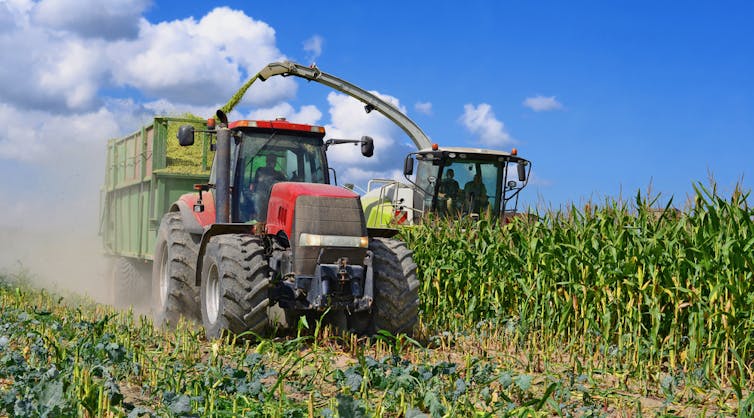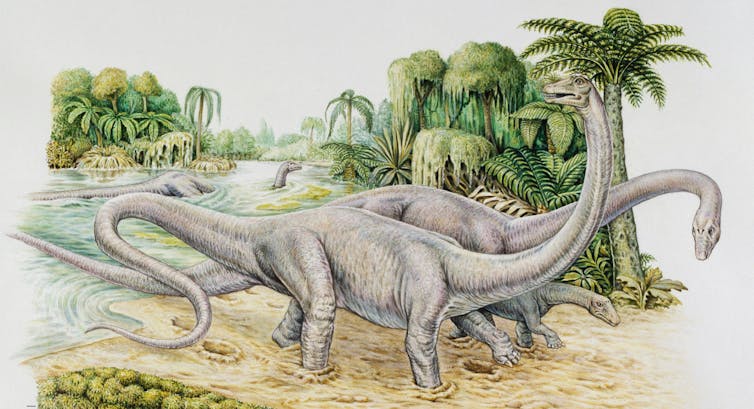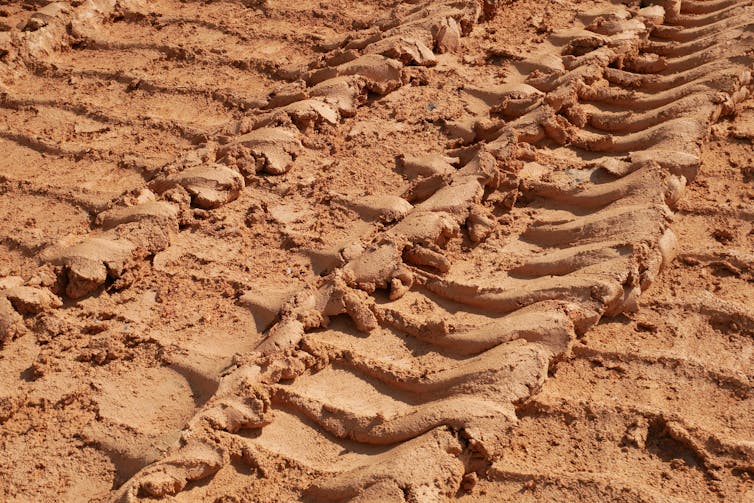A new study led by researchers from Sweden and Switzerland has found that the weight of farming machinery today is approaching that of the largest animals to have ever roamed the Earth – the sauropods.
Depicted as the giant, friendly “veggiesaurus” in the movie Jurassic Park, sauropods were the biggest of the dinosaurs. The heaviest were thought to weigh in at around 60 tonnes – similar to the weight of a fully laden combine harvester. Tractors and other machinery used on farms have grown enormously heavier over the past 60 years as intensive, large-scale agriculture has become widespread. A combine harvester is almost ten times heavier today than it was in the 1960s.
The weight of animals or machines matters because soils can only withstand so much pressure before they become chronically compacted. They may not look it, but soils are ecosystems containing fragile structures – pores and pathways which allow air to circulate and water to reach plant roots and other organisms. Tyres, animal hooves and human feet all apply pressure, squashing the pores, not just at the surface but deeper down too.
Under pressure
The study points out that as the weight of farm machinery has grown, tyre sizes have ballooned too, adjusting the area of contact between the vehicle with the soil to reduce the pressure on the surface and help avoid sinking. It seems that animals evolved with a similar strategy – increasing foot size with weight to help avoid sinking into the soil.

Overall, pressure at the soil surface has remained fairly constant as farm machinery has gained weight. But the authors suggest that stresses on the soil continue to increase below the surface and penetrate deeper as vehicles (or animals) get heavier. Farm machinery today (and the sauropods of the past) are now so heavy that they irreparably compact soil below the first 20 cm, where it isn’t tilled. Aside from restricting how deep the roots of crops can grow to seek water and nutrients further down in the soil, this can also create low-oxygen conditions that are not good for plants or the organisms they share the soil with.
Where did the dinosaurs go for dinner?
This creates a “sauropod paradox”, as the researchers call it. The dinosaurs and the loads transmitted through their feet were so large that they would have likely caused significant subsurface damage to soils wherever they roamed, potentially destroying the soil’s ability to support the plants and ecosystems they would have relied on as their food source.
The image of sauropods roaming widely and foraging freely as depicted by Jurassic Park seems unlikely, as they would have had an unsustainable influence on their environment. So how did they survive?
The scientists behind the study speculate that they may have kept to well-trodden paths, limiting their impact while browsing the canopy with their long necks. How exactly a sauropod could live in equilibrium with the soil remains a mystery for now.

Big food for thought
A more pressing conundrum is how to reconcile soil compaction by farming vehicles with sustainable food production today. The risk of soil compaction varies with the type of machinery and the way it’s used, as well as the type of soil and the moisture bound up in it.
The study estimates that 20% of croplands globally are at high risk of losing productivity because of subsoil compaction by modern agricultural vehicles, with the highest risks in Europe and North America where it’s relatively moist and there are more large farms using the largest machines. Clearly, this is an issue in arable landscapes, but the problem also extends to grasslands where silage is baled, and urban landscapes where the movement of construction vehicles on green space is not well controlled.

The authors call for design changes to machinery to help maintain the soil’s structure. We suggest another option. To reduce their impact on the soil, we could reduce the need for such large machines in the first place by growing food using smaller machines on smaller parcels of land, particularly in high-risk zones. Finding ways to break up vast monoculture landscapes makes sense for many other reasons. For example, wildflower field margins, hedgerows and trees can help sequester carbon, manage water quality and support biodiversity.
Soil can only withstand so much pressure – whether from compaction or other threats such as continual harvesting, erosion or pollution. Humans must act to reduce pressures on soils, or we risk going the way of the dinosaurs.















